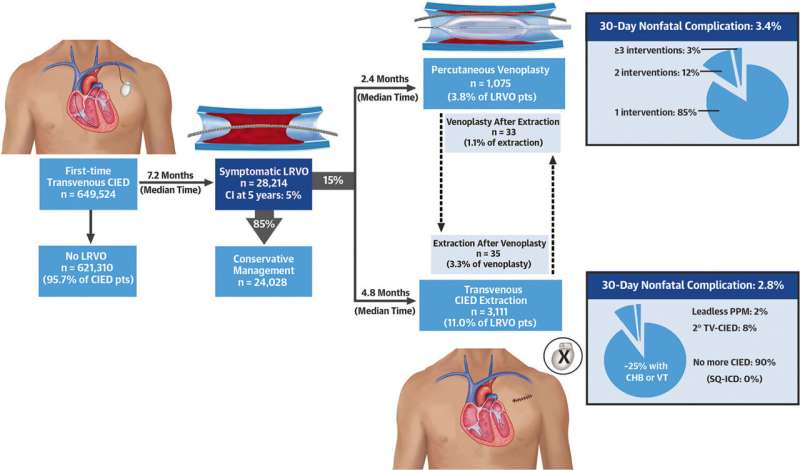Credit: Journal of the American College of Cardiology (2023). DOI: 10.1016/j.jacc.2023.04.017
About 3 million Americans live with cardiovascular implantable electronic devices—commonly known as pacemakers. These small electronic devices implanted in the chest or abdomen are typically used to treat slow or irregular heart rhythms and they can significantly improve patients' quality of life. But over time, scar tissue or blood clots can form around the leads, or wires, that carry the electrical impulses from the pacemaker to the heart.
Scar tissue or clots may hinder the flow of blood, potentially resulting in swollen extremities or pain. However, the incidence and clinical impact of such lead-related venous obstruction, or LRVO, among patients with pacemaker devices is not well characterized.
In a large, nationwide sample of Medicare beneficiaries, physician-researchers at the Richard A. and Susan F. Smith Center for Outcomes Research in Cardiology at Beth Israel Deaconess Medical Center (BIDMC) found that the incidence of symptomatic LRVO among patients implanted with cardiovascular implantable electronic devices to be four times higher than previously reported—with only a minority of patients being treated with an intervention.
The researchers also determined independent predictors of the complication as well as typical interventions and their outcomes. The team's findings were presented at the 44th annual Heart Rhythm Society Conference (HRS) held in New Orleans on May 19-21, and simultaneously published in the Journal of the American College of Cardiology, in order to provide new knowledge that could help better guide clinical decision making for these patients.
"Although LRVO can have severe adverse effects on patients' quality of life, most existing studies only partially capture the clinical relevance of this problem," said co-senior author Eric Secemsky, MD, MSc, director of Vascular Intervention at BIDMC. "Our study builds on existing data by following patients longitudinally and identifying symptoms severe enough that invasive action is required; even so, we believe our estimates of LRVO are likely conservative but lay the necessary foundations to understand this unrecognized yet likely widespread pathology."
The investigators looked at data from nearly 650,000 Medicare beneficiaries 65 years and older who received a cardiovascular implantable electronic device between 2016 and 2020 in the United States. The researchers found that five percent, or more than 28,000 patients, developed LRVO within five years.
Patients who also had chronic kidney disease or anemia, as well as Black individuals, had a higher prevalence of LRVO. When the researchers looked at characteristics that predicted the development of LRVO, they observed that patients whose devices had more than one lead were also at greater risk for developing LRVO, as were patients with anemia, malignancies or who were non-white.
Further, the investigators showed that more than 85 percent of patients who developed LRVO were treated conservatively; that is, they were treated without intervention. Among the 15 percent who underwent an invasive intervention, three-quarters had their pacemakers removed.
"Our findings showed an association between extraction of cardiovascular implantable electronic devices and a subsequent significant reduction in LRVO-related healthcare utilization, compared to conservative management," said co-senior author Peter J. Zimetbaum, MD, associate chief of BIDMC's CardioVascular Institute.
"However, additional prospective studies are needed to define best practices to manage this underdiagnosed condition, and characterize the safety and effectiveness profile of possible interventions that may improve outcomes for the patient."
Among the patients who had their devices removed, very few received another pacemaker or defibrillator. Just over two percent received leadless pacemakers, which would be expected to eliminate the risk of LRVO because they are directly implanted within the heart, without the need for leads. This approach also minimizes surgical incisions and is associated with reduced scarring. The remaining quarter had minimally invasive (catheter-based) procedures to expand the obstructed vein or place a stent—though none of these procedures was linked to a reduction in healthcare utilization.
"Evidence-based recommendations to guide LRVO management are needed as there has been a proliferation of novel therapeutic options for managing LRVO that are being applied without standardization," said first author Enrico G Ferro, MD, a cardiology fellow in the Smith Center.
"In addition to defining the absolute magnitude of the problem, our data helps clarify the time course for the development and treatment of symptomatic LRVO. As prompt diagnosis becomes more routine, physicians can eventually develop standardized treatment protocols that should also consider patient preferences, as interventions may reduce recurrent healthcare utilization."
More information: Enrico G. Ferro et al, Incidence, Treatment, and Outcomes of Symptomatic Device Lead-Related Venous Obstruction, Journal of the American College of Cardiology (2023). DOI: 10.1016/j.jacc.2023.04.017
Journal information: Journal of the American College of Cardiology
Provided by Beth Israel Deaconess Medical Center
























